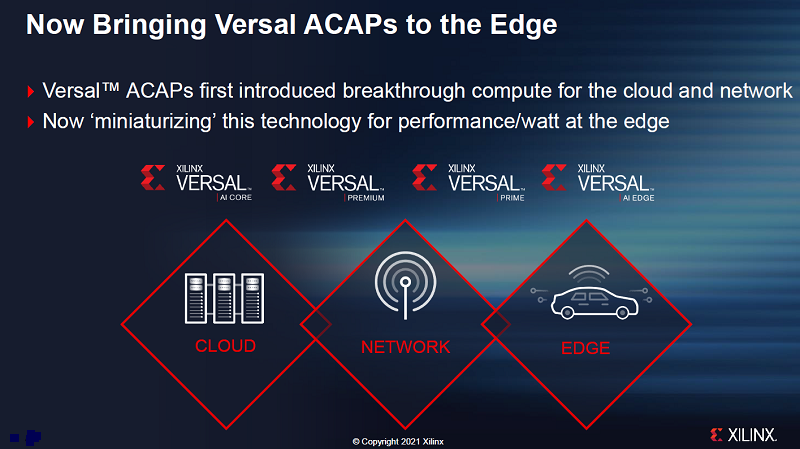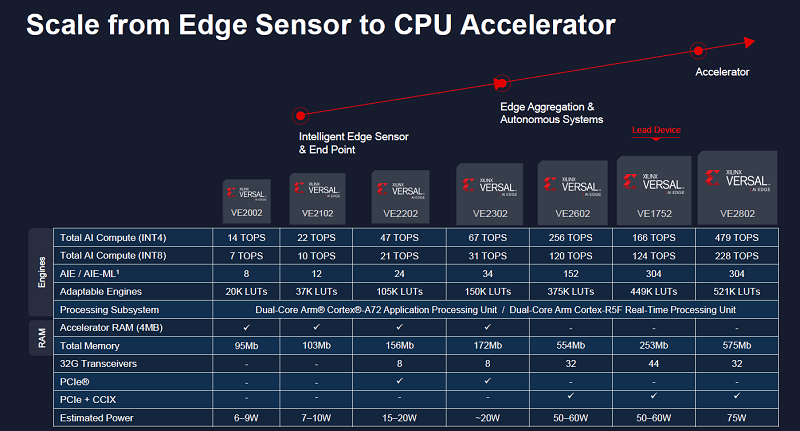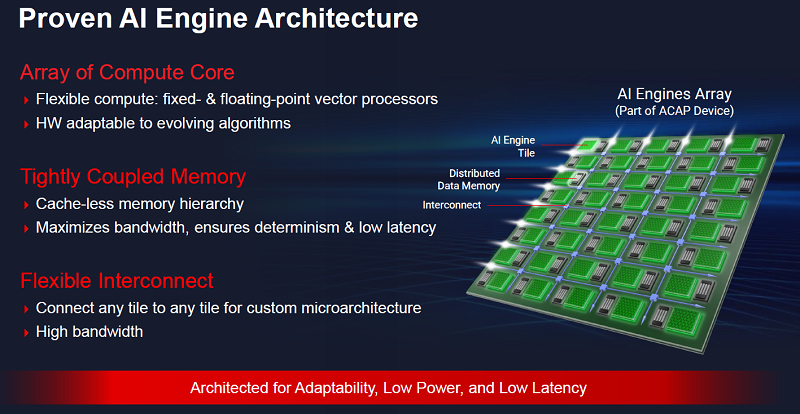FPGA chip vendor Xilinx has been busy over the last several years cranking out its Versal AI Core, Versal Premium and Versal Prime chip families to fill customer compute needs in the cloud, datacenters, networks and more.
Now Xilinx is expanding its reach to the booming edge computing marketplace, unveiling seven new chips in its latest Xilinx Versal AI Edge chip family. Expected to arrive in the first half of 2022, the Versal Edge AI chips are targeted to help customers with a wide range of real-time workloads from autonomous vehicles to robotics applications, industrial applications smart vision systems, medical uses, unmanned drones and even surgical robots. Versal AI Edge series design documentation and support is available to early access customers.
Built on the Versal family’s ongoing 7nm process technology, the Versal AI Edge chips use Xilinx’s existing Adaptive Compute Acceleration Platform (ACAP) architecture and its Vivado, Vitis and Vitis AI software applications to provide developers with the tools they need to create new edge designs for their companies, Rehan Tahir, Xilinx’s senior product line manager, told EnterpriseAI.
Vivado provides design tools for hardware developers, while Vitis is a unified software platform for software developers. Vitis AI is used by data scientists. Also available are domain-specific operating systems, frameworks and acceleration libraries to round out the platform’s toolsets.
The Versal ACAP architecture, which debuted in 2018, brought needed technology to the company’s earlier Versal chip families and is now being miniaturized to provide performance and low power requirements in a wide range of edge environments, said Tahir.
ACAPs are adaptive SoCs which combine scalar engines for embedded compute, adaptable engines for sensor fusion and hardware adaptability, and intelligent engines for AI inference. Also included are fast memory and interfaces that help deliver acceleration for applications.
“We have taken a lot of learnings from these [earlier] devices, and we are also bringing some optimizations to then make sure that these [new] devices are the perfect fit with the edge,” he said.
“Before 2018, there was no such thing as ACAPs,” said Tahir. “We introduced it with [the first] Versal chips. It is a category of device, adaptive SoCs. It is not just a pure FPGA. There are processors, there is programmable logic, there is other stuff going on. ACAP is the product category. If you had to say is this an ASIC or is this an ACAP, then clearly it is an ACAP because it has that programmability as part of the programmable logic that you don’t have it in an ASIC or an ASSP.”
Tahir said that puts the Versal AI Edge series in with other AI chips under a broad umbrella. “An AI chip to me is a broad term. AI chips include GPUs, it includes ASSPs that have some type of AI acceleration mechanism, and it absolutely includes these ACAPs because we have these AI engines specifically geared for AI applications. That is the whole reason those AI engines are there.”
Traditional FPGAs often get a bad rap because they can be hard to program, said Tahir. “And we are trying to solve that problem [with the Versal AI Edge series]. And through our Vitus and Vitus AI [software], the goal is to have everything there and make it as easy as possible for the developers.”
Xilinx claims the new Versal AI Edge chip family provides 4x performance-per-watt over GPUs and 10x greater compute density over its own previous generation of chips, the Xilinx Zynq UltraSCALE+ MPSoCs (multiple processor system-on-chips), while also providing reduced latency and flexible architectures. The Zynq UltraSCALE+ chips were built on 16nm process nodes, compared to the 7nm process nodes of the new Versal AI Edge series.
Versal AI Edge Specs
The Versal AI Edge series starts with the VE2002 chip, which consumes six to nine watts of power, provides 14 TOPS of INT4 or 7 TOPS of INT8 performance, and includes 95MB of total memory. The VE2102 chip consumes seven to 10 watts of power, provides 22 TOPS of INT4 or 10 TOPS of INT8 performance, and includes 103MB of memory, followed by the VE2022 chip, which consumers 15 to 20 watts of power and provides 47 TOPS of INT4 or 21 TOPS of INT8 performance, along with 156MB of memory.
Next up is the Versal Edge AI VE2302 chip, which consumes less than 20 watts of power, provides 67 TOPS of INT4 or 31 TOPS of INT8 performance, and includes 172MB of memory.
Rounding out the line-up are the VE2602, which consumes 50 to 60 watts of power while providing 256 TOPS of INT4 or 120 TOPS of INT8 performance along with 554MB of memory; the VE1752, which consumes 50 to 60 watts of power while providing 166 TOPS of INT4 or 124 TOPS of INT8 performance along with 253MB of memory; and the VE2802, which consumes 75 watts of power and provides 479 TOPS of INT4 or 228 TOPS of INT8 performance. The VE2802 includes 575MB of memory.
All seven Versal AI Edge chip models feature dual-core Arm Cortex-A72 CPUs and dual-core Arm Cortex-R5F processors for meeting real-time application requirements.
The VE2002 includes eight AI engine/ML engine tiles, while the VE2101 includes 12 tiles. The VE2202 includes 24 tiles, the VE2302 includes 34, the VE2602 includes 152 tiles and the VE2802 includes 304 tiles. TheVE1752 is equipped with 304 tiles, but they are only AI engine tiles.
The chips range in size from 19mm x 19mm for the VE2002 to 35mm x 35mm for the VE1752.
Full Programmability for Flexibility
Because they are FPGAs with Xilinx’s ACAP architecture built in, they are fully software and hardware programmable, which can even be done on-the-fly, said Tahir.
“There’s the programmable logic that is inside of our devices, what we call the adaptable engines,” he said. “What makes Xilinx unique from ASSPs (Application-Specific Standard Products) and GPUs is that our chips are programmable and those are not. You can go in and customize how you want to do the localization, how you want to do the mapping, the sensor fusion.”
In addition, there are Arm-based real-time and application processors on the chips, which allow developers working on autonomous vehicles to make decisions that will influence the vehicle and how it can be controlled and interface with the driver, said Tahir.
“The whole application is accelerated because we have the programmability and the adaptive engines, we have the AI/ML compute capability in the intelligent engines, and then we’ve got the processors to act in scalar engines,” he said.
Xilinx already has successful engagements with nearly all automotive companies today, said Tahir. “The Versal AI Edge series will only continue that success.”
Continue reading at EnterpriseAI.news.
"chips" - Google News
June 11, 2021 at 12:11PM
https://ift.tt/3zd81HE
Xilinx Expands Versal Chip Family With 7 New Versal AI Edge Chips - HPCwire
"chips" - Google News
https://ift.tt/2RGyUAH
https://ift.tt/3feFffJ
Bagikan Berita Ini

















0 Response to "Xilinx Expands Versal Chip Family With 7 New Versal AI Edge Chips - HPCwire"
Post a Comment